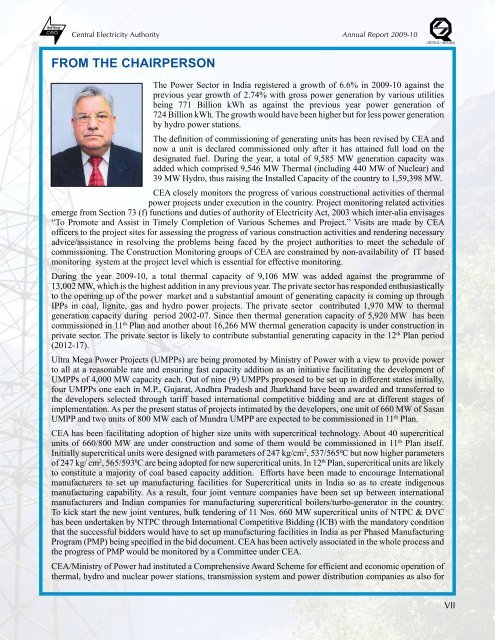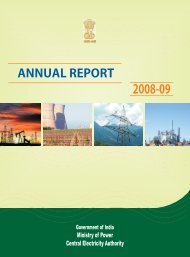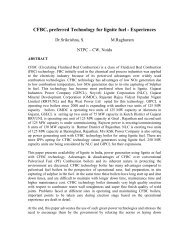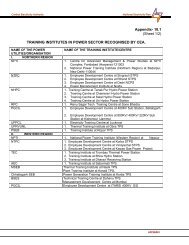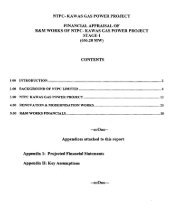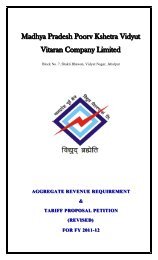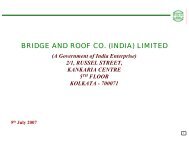thermal power development - Infraline
thermal power development - Infraline
thermal power development - Infraline
You also want an ePaper? Increase the reach of your titles
YUMPU automatically turns print PDFs into web optimized ePapers that Google loves.
Central electricity authority Annual Report 2009-10<br />
From the Chairperson<br />
The Power Sector in India registered a growth of 6.6% in 2009-10 against the<br />
previous year growth of 2.74% with gross <strong>power</strong> generation by various utilities<br />
being 771 Billion kWh as against the previous year <strong>power</strong> generation of<br />
724 Billion kWh. The growth would have been higher but for less <strong>power</strong> generation<br />
by hydro <strong>power</strong> stations.<br />
The definition of commissioning of generating units has been revised by CEA and<br />
now a unit is declared commissioned only after it has attained full load on the<br />
designated fuel. During the year, a total of 9,585 MW generation capacity was<br />
added which comprised 9,546 MW Thermal (including 440 MW of Nuclear) and<br />
39 MW Hydro, thus raising the Installed Capacity of the country to 1,59,398 MW.<br />
CEA closely monitors the progress of various constructional activities of <strong>thermal</strong><br />
<strong>power</strong> projects under execution in the country. Project monitoring related activities<br />
emerge from Section 73 (f) functions and duties of authority of Electricity Act, 2003 which inter-alia envisages<br />
“To Promote and Assist in Timely Completion of Various Schemes and Project.” Visits are made by CEA<br />
officers to the project sites for assessing the progress of various construction activities and rendering necessary<br />
advice/assistance in resolving the problems being faced by the project authorities to meet the schedule of<br />
commissioning. The Construction Monitoring groups of CEA are constrained by non-availability of IT based<br />
monitoring system at the project level which is essential for effective monitoring.<br />
During the year 2009-10, a total <strong>thermal</strong> capacity of 9,106 MW was added against the programme of<br />
13,002 MW, which is the highest addition in any previous year. The private sector has responded enthusiastically<br />
to the opening up of the <strong>power</strong> market and a substantial amount of generating capacity is coming up through<br />
IPPs in coal, lignite, gas and hydro <strong>power</strong> projects. The private sector contributed 1,970 MW to <strong>thermal</strong><br />
generation capacity during period 2002-07. Since then <strong>thermal</strong> generation capacity of 5,920 MW has been<br />
commissioned in 11 th Plan and another about 16,266 MW <strong>thermal</strong> generation capacity is under construction in<br />
private sector. The private sector is likely to contribute substantial generating capacity in the 12 th Plan period<br />
(2012-17).<br />
Ultra Mega Power Projects (UMPPs) are being promoted by Ministry of Power with a view to provide <strong>power</strong><br />
to all at a reasonable rate and ensuring fast capacity addition as an initiative facilitating the <strong>development</strong> of<br />
UMPPs of 4,000 MW capacity each. Out of nine (9) UMPPs proposed to be set up in different states initially,<br />
four UMPPs one each in M.P., Gujarat, Andhra Pradesh and Jharkhand have been awarded and transferred to<br />
the developers selected through tariff based international competitive bidding and are at different stages of<br />
implementation. As per the present status of projects intimated by the developers, one unit of 660 MW of Sasan<br />
UMPP and two units of 800 MW each of Mundra UMPP are expected to be commissioned in 11 th Plan.<br />
CEA has been facilitating adoption of higher size units with supercritical technology. About 40 supercritical<br />
units of 660/800 MW are under construction and some of them would be commissioned in 11 th Plan itself.<br />
Initially supercritical units were designed with parameters of 247 kg/cm 2 , 537/565 0 C but now higher parameters<br />
of 247 kg/ cm 2 , 565/593 0 C are being adopted for new supercritical units. In 12 th Plan, supercritical units are likely<br />
to constitute a majority of coal based capacity addition. Efforts have been made to encourage International<br />
manufacturers to set up manufacturing facilities for Supercritical units in India so as to create indigenous<br />
manufacturing capability. As a result, four joint venture companies have been set up between international<br />
manufacturers and Indian companies for manufacturing supercritical boilers/turbo-generator in the country.<br />
To kick start the new joint ventures, bulk tendering of 11 Nos. 660 MW supercritical units of NTPC & DVC<br />
has been undertaken by NTPC through International Competitive Bidding (ICB) with the mandatory condition<br />
that the successful bidders would have to set up manufacturing facilities in India as per Phased Manufacturing<br />
Program (PMP) being specified in the bid document. CEA has been actively associated in the whole process and<br />
the progress of PMP would be monitored by a Committee under CEA.<br />
CEA/Ministry of Power had instituted a Comprehensive Award Scheme for efficient and economic operation of<br />
<strong>thermal</strong>, hydro and nuclear <strong>power</strong> stations, transmission system and <strong>power</strong> distribution companies as also for<br />
vii


